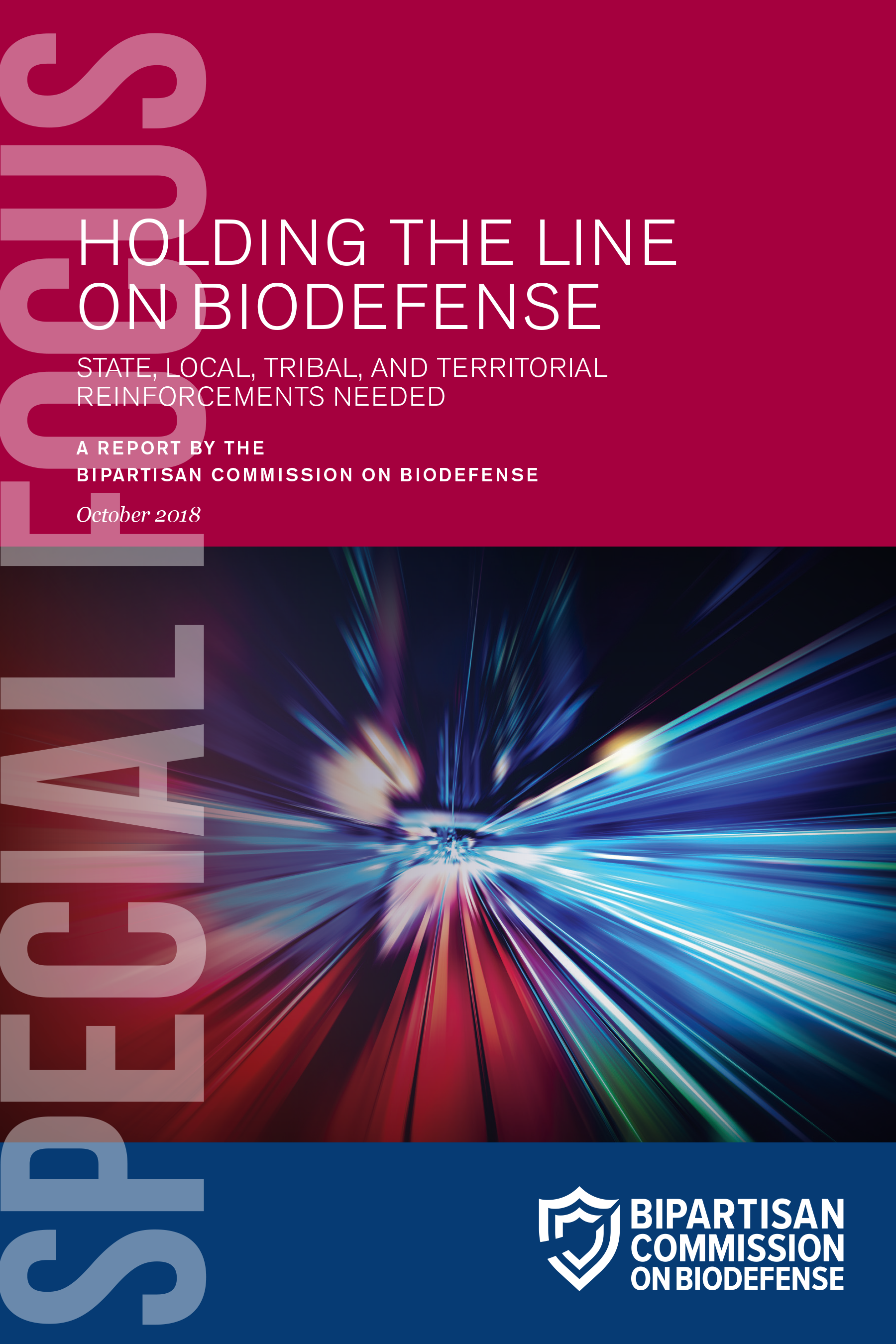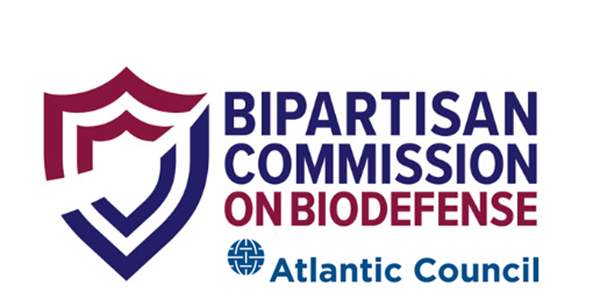Holding the Line on Biodefense
State, Local, Tribal, and Territorial Reinforcements Needed
NOTE: The Blue Ribbon Study Panel on Biodefense is now the BIPARTISAN COMMISSION ON BIODEFENSE

- Executive Summary
- Hypothetical Scenario For Multiple Unexplained Outbreaks Of Plague
- Introduction
- Fortify Emergency Medical Services
- Improve Stockpile Distribution And Pharmacy Readiness
- Increase Health Care Surge Capacity
- Augment Laboratory Response
- Rectify Shortfalls In Tribal Public Health Emergency Preparedness
- Overcome Barriers To Territorial Biosurveillance And Emergency Response
- Allocate Response Funding Before Biological Crises Occur Assume Broader
- Assume Broader Leadership Of Biodefense
- Conclusion
- Appendix A: All Commission SLTT Recommendations To-Date
- Appendix B: Proposed Gubernatorial Hearings
- Appendix C: Proposed Congressional Hearings
- Appendix D: Methodology
- Appendix E: Meeting Agenda And Speakers
- Acronyms
- Endnotes
Commissioners
Joseph I. Lieberman, Chair
Thomas J. Ridge, Chair
Donna E. Shalala
Thomas A. Daschle
James C. Greenwood
Kenneth L. Wainstein
Ex Officio Members
Yonah Alexander, PhD
William B. Karesh, DVM
Rachel Levinson, MA
I. Lewis Libby, JD
Gerald W. Parker, DVM, PhD
George Poste, DVM, PhD, DSc
Tevi Troy, PhD
Commission Staff
Asha M. George, DrPH, Executive Director
Robert H. Bradley, Policy Associate
Patty Prasada-Rao, MPH, Panel Coordinator
Patricia de la Sota, Meeting Coordinator
Ellen P. Carlin, DVM, Senior Advisor
Hailey Mody, Intern
Acknowledgments
The Commission thanks Hudson Institute for serving as our fiscal sponsor and the University of Miami for hosting the Commission’s public meeting on this topic. We thank Martin Masiuk, President, IMR Group, and the Preparedness Leadership Council for sharing their discussions with us. We are especially indebted to numerous federal, state, local, tribal, and territorial emergency medical services, health care, and public health representatives, boards, and associations for their frank comments. We thank our ex officio members for their advice and input. The Commission also gratefully acknowledges the financial support provided by its donors.
Executive Summary
The US Census Bureau counts a staggering 89,004 local governments in the United States. Among them are 3,031 counties, 19,522 municipalities and 16,364 townships.1 There are 573 tribes,2 14 territories, and thousands of other special districts across America–each with a responsibility to serve the people who call those places home. Sometimes that service is in response to an emergency.
Our hometown heroes – emergency medical services, police, firefighters, doctors, nurses, pharmacists, lab technicians, public health professionals – are on the front lines keeping us safe. Maybe it’s from a flash flood from a stalled rainstorm. Perhaps it’s from a derailed train carrying hazardous liquids. These types of incidents can be handled with resources provided by local and state governments, but when events are severe – widespread in scope and damage – they may require intervention by our federal government. Whether it’s a terrorist attack (e.g., September 11, 2001) or a natural disaster (e.g., Hurricane Katrina), the nation will quickly step up and respond, offering additional support and funding.
Unfortunately, there is grave concern that a large-scale biological event will prove to be the exception to this rule. Devastation could be vast and swift, and local resources would be very quickly depleted. The thousands of state, local, tribal, and territorial (SLTT) governments that are the backbone of our nation will have to fend for themselves for far too long until federal assets arrive, and Congress can provide emergency supplemental funding to support response and recovery.
In October 2015, the Bipartisan Commission on Biodefense issued its first report, A National Blueprint for Biodefense: Leadership and Major Reform Needed to Optimize Efforts. The majority of the report’s recommendations focused on our national government, touching only briefly on SLTT needs. The Commission promised to return to them later and revisited these issues during a special focus meeting on the campus of the University of Miami in January 2018. The Commission explored needed SLTT emergency medical services, hospital, pharmacy, laboratory, and public health department capabilities and capacities necessary to respond to large-scale biological events.
The Commission found that basic biological preparedness, response, and recovery infrastructure varies widely throughout the United States, placing the entire nation at risk. If one community, for example, does not have access to a laboratory in their state that can quickly identify a biological threat, then they are immediately vulnerable and so are those who live in bordering states. It reminds us that states, localities, tribes, and territories play a huge role in national security. We would like to see state governors, territorial governors and administrators, tribal leaders, mayors, borough council presidents, and township supervisors make biodefense a greater priority before biological attacks, accidents, outbreaks, epidemics, and pandemics place the lives of their constituents at risk.
In the pages that follow, the Commission recommends key steps that will increase the capability of SLTT to share with the federal government the burden of preparedness for, response to, and recovery from large-scale biological events. These eight recommendations are:
- Unify and establish a new National Emergency Medical Services system, including the creation of a National Emergency Medical Services Agency at the Department of Health and Human Services.
- Improve distribution of the Strategic National Stockpile and other stores of pharmaceuticals, equipment, and essential medical supplies, with enhanced training and assured access to pharmacy readiness data.
- Layer health care delivery across the nation and plan for when hospitals and other facilities are overwhelmed and overrun.
- Authorize all laboratory response networks to test for biological agents.
- Allow federally recognized tribes to enter into their own Public Health Emergency Preparedness cooperative agreements with the Centers for Disease Control and Prevention.
- Strengthen biosurveillance in, and eliminate burdensome transportation requirements for, the territories.
- Allocate response funding before biological crises occur with a credible Public Health Emergency Fund and sufficient assistance under the Stafford Act.
- Address public expectations by making biodefense a priority for all elected leaders throughout the nation.
Copyright © 2018 by the Bipartisan Commission on Biodefense. All rights reserved.
Cover image courtesy of Shutterstock.com.
Bipartisan Commission on Biodefense. Holding the Line on Biodefense: State, Local, Tribal, and Territorial Reinforcements Needed. Bipartisan Commission on Biodefense: Washington, DC. October 2018.
